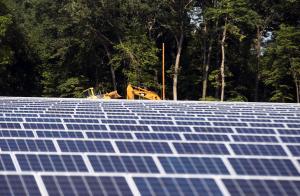Astonishing figures show that the total cost of renewable energy infrastructure in Europe to the end of 2012 came to over €600 billion, excluding additional fees for grid connections and upgrades.
And this enormous sum is one and a half times the cost of twice bailing out the Greek economy, which came to €320 billion and the Irish economy with a €70 billion loan, the Irish Energy Blog has calculated.
With Alexis Tsipras in Brussels meeting European Commission President Jean Claude Juncker to discuss the refinancing of the country’s debt, it should be hard to believe that the financial prison the Greek people have been living in could have been spent in a worse fashion. But the money for on and off shore wind turbines and solar panels has not contributed to any meaningful reduction in political energy targets nor has it benefitted households: in fact, it has led to the reverse with higher bills and a less stable supply of energy, essential in a modern economy for both practicality and security.
In the UK there is an average £68 added onto a family’s energy bills to subsidise projects such as wind farms and biomass plants, according to official analysis published last November. And these levies are set to more than double by 2020 and treble by 2030, figures show. These surcharges account for about five per cent on an annual energy bill of £1,369.
These amounts are forecast to rise significantly to fund more wind farms and nuclear power plants, with levies expecting to reach £141 a year in 2020 and £226, or fifteen per cent of an annual bill, in 2030.
This means that despite spending billions on projects which were supposed to not only cut carbon emissions but were going to stimulate a new industry in ‘green energy’, the money has instead been wasted. Because not only must the €600 billion must be paid back to shareholders in these companies but the higher cost of energy has made the continent less competitive for energy intensive industries.
Yet despite these huge sums being spent on politically motivated projects, more often than not taking money from poorer households and giving it to rich land owners, Europe is still as dependent on external fossil fuels – potentially more so since governments took their eye off the ball on nuclear energy production, leaving a gap in supply which will not be picked up by a few turbines – especially if the wind stops blowing. And it’s the neglect of these traditional energy sources which will have the biggest consequences in years to come.
In addition, it’s left Russia in a strong position diplomatically, seen in the reticence of the Germans over fighting in the Ukraine and the response to human rights abuses in Saudi Arabia. At the same time, not one conventional power plant has been shut down anywhere in Europe and replaced by the renewable infrastructure.
The European Network of Transmission Systems Operators recently reported the effects these policies have had on energy production and supply. The latest Winter Outlook Report stated:
‘Similar to the peak demand analysis, it provides an indication which countries require exports to manage inflexible generation. Indeed, this involved an analysis of their ability to export this energy to neighbouring regions that are not in a similar situation. The reason for this analysis pertains to the fact that a number of TSOs expressed that they are experiencing growing problems for system operation (mainly) due to the increase of variable generation on the system (wind and solar) and the lack of more flexible generation means.’

COMMENTS
Please let us know if you're having issues with commenting.